


Blur the boundaries between digital and acoustic sound.
With Never Sol about the UMPRUM.wav project
At Milan Design Week from April 17th to 23rd 2023, UMPRUM will present UMPRUM.wav, an interactive project that explores the relationship between sound and design through five acoustic musical instruments. During a semester dedicated to music, students from the Product Design Studio met with musicians, producers, sound designers, and other experts who passed on their knowledge and experience. We spoke to musician Never Sol about her involvement in the project, how it was working with the instruments, and the role the visitor will play in the exhibition.
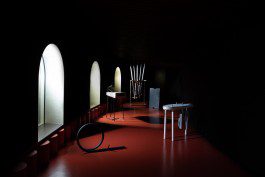
Photo: Markéta Slaná
The theme of the winter semester of the Product Design Studio was music. You prepared a workshop for the students. Who approached you to collaborate and what did you focus on?
I was approached by the head of the studio Michal Froněk with the idea that it would be good to demonstrate and illuminate the process of creating sound as such. I focused on my live setup, through which I felt it would be possible to get the quickest insight into the creative process, to understand the general manipulation of the sound source. I wanted to show how sound can inspire subsequent modifications and to share overall what I'm thinking about when I improvise or create. The modular synth is quite nice to read in this way, and I think it makes it possible to break down the musical whole - the track - into as few building blocks as possible.

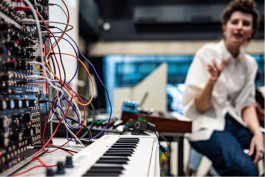
Never Sol during the workshop
The students ended up creating acoustic instruments - was there anything about the experimental instruments that surprised or intrigued you?
I was overall surprised by the great level of commitment to the topic and how carefully the students grasped it. I felt that in a very short amount of time, they were able to understand the basics of acoustics and were trying to understand the inner workings of the instruments at a level that allowed them to really play the instrument realistically and create interesting sonic content. I think it's really admirable in such a short time to understand, invent and produce something that truly inspires the next link in the chain, like me, to create.
You were also involved in the next phase of the project - recording the sounds of the instruments. How did it go? Was it difficult to tune the instruments and play them?
We met with Sarah Jedličková and Ivo Jedlička in the studio a few times before recording and tried to tune the instruments on a general basis. Finding a specific tuning is not such a problem until the moment when three instruments have to play together - then, for example, the strings have to adapt their tuning to something that can't be tuned that well - like the brass, didgeridoo, or organ. We then used these instruments to create the tracks harmonically and then adapted the tuning of the others to them. The recording was a long jam session, we tried to capture all the sounds that could be created on the instruments.
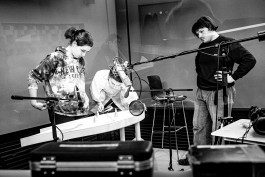
Sarah, Sára and Ivo are tuning the Monochord
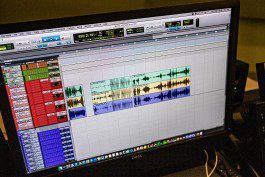
Soundtracks of recorded instruments
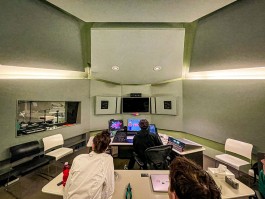
Recording instruments in the Soundsquare studio
How did you subsequently work with the sample recordings and how will the sound be presented at the Milan exhibition?
Personally, I did a lot of layering, and processing, I generally tried to get a feel for what is natural to each instrument, what kind of sound atmosphere, mood, and colour it creates. I tried to differentiate the tracks slightly in tempo, energy, and dynamics, but at the same time, I wanted to preserve the natural character of each instrument and somehow capture its essence. The instruments will be on display at the exhibition and the visitor will be able to control the volume levels of the instruments - mixing the sound themselves within the pre-made tracks, thanks to a controller that the students also designed.
You work with the layering of synthetic sounds and vocals in your work. How was working with acoustic instruments different for you?
I would say that where I have the ability to layer, and it's mostly everywhere, I layer, whatever. I enjoy blending different colors and characters within a track, and in general, creating surfaces that are not completely recognizable because of the layering.
A musical instrument is a complex design problem. You compose your own synthesizers so that their sound accurately expresses your musical vision. Has the product design students' perspective on music been of any use to you?
Definitely, it was especially beneficial to be in their presence and to feel how they think about the problem, how they approached fabrication, and what they chose to create, definitely inspires me. The instruments are functional and they're really good, so it's great to see how the source of the sound is created in a different context again.
The UMPRUM.wav exhibition at Milan Design Week will also be enriched by performances of Czech and Italian musicians, including yours truly. What can we look forward to?
We've managed to arrange a performance by an amazing musician and modular synth developer, Alina Kalancey, the woman behind her synth company Soundfreak Modular, and she'll be performing with Sarah Jedlicka on Friday. Alina is a big inspiration to me and I think it's going to be a really nice connection. Tuesday's concert - jam session will be more jazz, featuring double bassist Danillo Gallo and instrumentalist and vocalist Kathya West.
The interview was conducted by Zuzana Řičářová from the Department of Theory and History of Art.
Sára Vondrášková alias Never Sol is a Czech musician, composer, and producer, one of the most prominent personalities of the Czech alternative scene. She studied jazz singing at the Jaroslav Ježek Conservatory. She works mainly with synthetic sound, which in combination with vocals creates distinctive melancholic atmospheric soundscapes. She also composes music for films and theatre performances and hosts a music programme on the Vltava radio station.
Zuzana Řičářová is a graduate of the Department of Art History at Charles University and is currently studying for a Master's degree in Theory and History of Contemporary and Modern Art at UMPRUM. Her main interest is the environmental and social context of design.
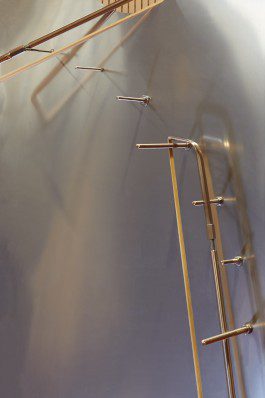

1000x600
author: Natália Krišťáková
In The 1000x600, Natalia aimed to create a simplistic musical instrument whose body consists entirely of interconnected prefabricated components: metal sheet, screws and nuts. The concept of this experimental instrument was inspired by an experience with bowed saws. It is based on the idea of translating the mechanical wave of the rectangular metal plate into the sound waves. By tipping the sheet from side to side, the air vibrates and the tones are produced. The bent metal plate placed on the stand acts as a resonant plate for the drilled-in bars: seven screws with double nuts of different diameters placed by the top and left edge of the sheet. Similarly to the Euphone, this instrument translates the movement of the bow into the ethereal sounds.
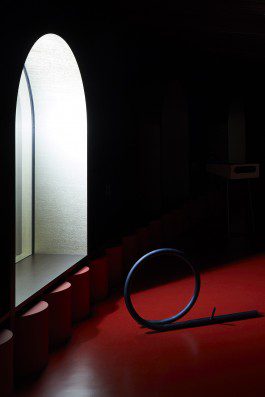
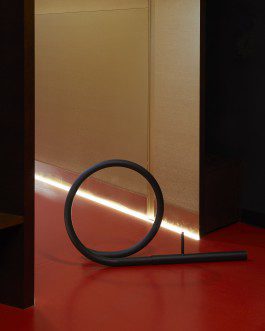
Didj
author: Karolína Vintrová
The instrument derived from a traditional Australian Aboriginal wind instrument, now widely known as the didgeridoo. The body of Karolína’s Didj is welded from three components, and the fourth movable part with a handle functions as a telescoping slide mechanism. By adjusting the length of the tube, the player can alter the pitch of the instrument: the longer the tube, the lower the tone. Its circular shape was chosen to promote closer contact with the instrument, for the player to be literally embraced by it. As with the traditional didgeridoo, the emphasis here is on the bond between the player and the instrument. The players need to master circular breathing, thus maintaining a continuous sound.
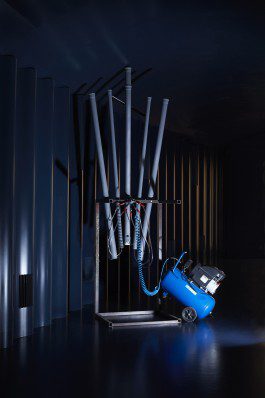
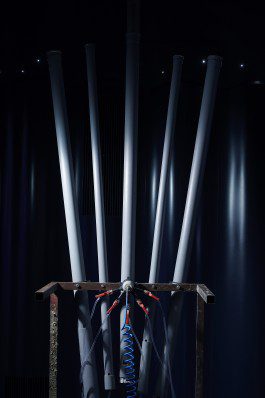
Organ
author: Miloslav Chytil
Exceptional technological complexity, a certain mysterious sound, and an emotional relationship with the instrument were the three initial criteria that inspired the creation of the pipe organ. Without unnecessary decorative elements, Miloslav focused on the practical functioning of this machine-like instrument. Here, an air compressor acts as the wind system that generates the pressurized air (the wind). The wind then flows through a simple windchest into the pipes, creating the sound. Each of the pipes is made of plumbing material and corresponds to a pitch in C major: C, D, E, G, and B. The whole system is suspended on a metal frame. Although somewhat unconventional in its design, the fan-like arrangement of the pipes mimics the way a player is consumed by the monumentality of the classical organ.
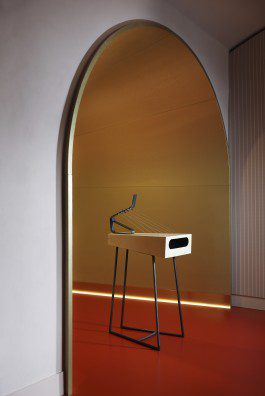
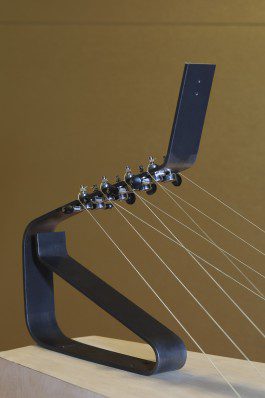
Mora
author: Theodor Hozák
Theodor’s Mora is a chordophone where one hand controls the bow and the other hand strums the strings. On one end the strings are attached to the wooden sound box, and on the other to a metal arm using standard guitar pegheads. The desired tone can be further adjusted by pulling and bending the flexible metal arm, which also serves as the neck of the instrument and transmits vibrations generated on the strings to the soundboard. The rectangular body sits on a metal pedestal that does not affect the sound coming from the oval opening in the sound box while simultaneously positioning the instrument at an optimal height for a standing player.
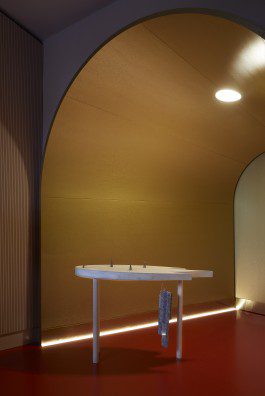
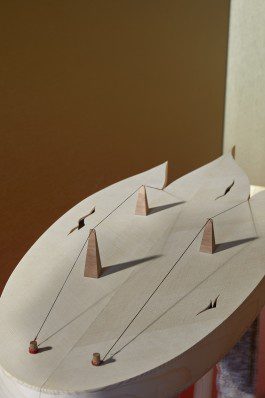
Monochord
author: Ivo Jedlička
The monochord, which was famously used by Pythagoras as a tool to observe connections between music, mathematics, and astronomy, served as the inspiration behind Ivo’s instrument. The body consists of an oval echo chamber with a spruce timber soundboard, two strings and three or more non-fixed bridges. The strings are attached to the board with pins and are weighed down by granite rocks. At the point of contact with the wood, the strings cut into the wood and form the instrument's distinctive shape. For optimal ergonomics, the Monochord is placed on three legs. Different tones are created by moving the bridges and changing the length ratios of the individual strings; it can be played with a bow, drumstick or by strumming, akin to a violin or a dulcimer. Its simple yet sophisticated concept makes it an ideal educational instrument to deeply understand the mathematical relationships between intervals.
Photos of musical instruments: Markéta Slaná
The photographs of musical instruments were taken at the Rudolfinum in the EDUcentre of the Czech Philharmonic Educational Programmes Department. The project was designed by 0,5 Studio.
Blur the boundaries between digital and acoustic sound.
With Never Sol about the UMPRUM.wav project
At Milan Design Week from April 17th to 23rd 2023, UMPRUM will present UMPRUM.wav, an interactive project that explores the relationship between sound and design through five acoustic musical instruments. During a semester dedicated to music, students from the Product Design Studio met with musicians, producers, sound designers, and other experts who passed on their knowledge and experience. We spoke to musician Never Sol about her involvement in the project, how it was working with the instruments, and the role the visitor will play in the exhibition.

Photo: Markéta Slaná
The theme of the winter semester of the Product Design Studio was music. You prepared a workshop for the students. Who approached you to collaborate and what did you focus on?
I was approached by the head of the studio Michal Froněk with the idea that it would be good to demonstrate and illuminate the process of creating sound as such. I focused on my live setup, through which I felt it would be possible to get the quickest insight into the creative process, to understand the general manipulation of the sound source. I wanted to show how sound can inspire subsequent modifications and to share overall what I'm thinking about when I improvise or create. The modular synth is quite nice to read in this way, and I think it makes it possible to break down the musical whole - the track - into as few building blocks as possible.


Never Sol during the workshop
The students ended up creating acoustic instruments - was there anything about the experimental instruments that surprised or intrigued you?
I was overall surprised by the great level of commitment to the topic and how carefully the students grasped it. I felt that in a very short amount of time, they were able to understand the basics of acoustics and were trying to understand the inner workings of the instruments at a level that allowed them to really play the instrument realistically and create interesting sonic content. I think it's really admirable in such a short time to understand, invent and produce something that truly inspires the next link in the chain, like me, to create.
You were also involved in the next phase of the project - recording the sounds of the instruments. How did it go? Was it difficult to tune the instruments and play them?
We met with Sarah Jedličková and Ivo Jedlička in the studio a few times before recording and tried to tune the instruments on a general basis. Finding a specific tuning is not such a problem until the moment when three instruments have to play together - then, for example, the strings have to adapt their tuning to something that can't be tuned that well - like the brass, didgeridoo, or organ. We then used these instruments to create the tracks harmonically and then adapted the tuning of the others to them. The recording was a long jam session, we tried to capture all the sounds that could be created on the instruments.

Sarah, Sára and Ivo are tuning the Monochord

Soundtracks of recorded instruments

Recording instruments in the Soundsquare studio
How did you subsequently work with the sample recordings and how will the sound be presented at the Milan exhibition?
Personally, I did a lot of layering, and processing, I generally tried to get a feel for what is natural to each instrument, what kind of sound atmosphere, mood, and colour it creates. I tried to differentiate the tracks slightly in tempo, energy, and dynamics, but at the same time, I wanted to preserve the natural character of each instrument and somehow capture its essence. The instruments will be on display at the exhibition and the visitor will be able to control the volume levels of the instruments - mixing the sound themselves within the pre-made tracks, thanks to a controller that the students also designed.
You work with the layering of synthetic sounds and vocals in your work. How was working with acoustic instruments different for you?
I would say that where I have the ability to layer, and it's mostly everywhere, I layer, whatever. I enjoy blending different colors and characters within a track, and in general, creating surfaces that are not completely recognizable because of the layering.
A musical instrument is a complex design problem. You compose your own synthesizers so that their sound accurately expresses your musical vision. Has the product design students' perspective on music been of any use to you?
Definitely, it was especially beneficial to be in their presence and to feel how they think about the problem, how they approached fabrication, and what they chose to create, definitely inspires me. The instruments are functional and they're really good, so it's great to see how the source of the sound is created in a different context again.
The UMPRUM.wav exhibition at Milan Design Week will also be enriched by performances of Czech and Italian musicians, including yours truly. What can we look forward to?
We've managed to arrange a performance by an amazing musician and modular synth developer, Alina Kalancey, the woman behind her synth company Soundfreak Modular, and she'll be performing with Sarah Jedlicka on Friday. Alina is a big inspiration to me and I think it's going to be a really nice connection. Tuesday's concert - jam session will be more jazz, featuring double bassist Danillo Gallo and instrumentalist and vocalist Kathya West.
The interview was conducted by Zuzana Řičářová from the Department of Theory and History of Art.
Sára Vondrášková alias Never Sol is a Czech musician, composer, and producer, one of the most prominent personalities of the Czech alternative scene. She studied jazz singing at the Jaroslav Ježek Conservatory. She works mainly with synthetic sound, which in combination with vocals creates distinctive melancholic atmospheric soundscapes. She also composes music for films and theatre performances and hosts a music programme on the Vltava radio station.
Zuzana Řičářová is a graduate of the Department of Art History at Charles University and is currently studying for a Master's degree in Theory and History of Contemporary and Modern Art at UMPRUM. Her main interest is the environmental and social context of design.


1000x600
author: Natália Krišťáková
In The 1000x600, Natalia aimed to create a simplistic musical instrument whose body consists entirely of interconnected prefabricated components: metal sheet, screws and nuts. The concept of this experimental instrument was inspired by an experience with bowed saws. It is based on the idea of translating the mechanical wave of the rectangular metal plate into the sound waves. By tipping the sheet from side to side, the air vibrates and the tones are produced. The bent metal plate placed on the stand acts as a resonant plate for the drilled-in bars: seven screws with double nuts of different diameters placed by the top and left edge of the sheet. Similarly to the Euphone, this instrument translates the movement of the bow into the ethereal sounds.


Didj
author: Karolína Vintrová
The instrument derived from a traditional Australian Aboriginal wind instrument, now widely known as the didgeridoo. The body of Karolína’s Didj is welded from three components, and the fourth movable part with a handle functions as a telescoping slide mechanism. By adjusting the length of the tube, the player can alter the pitch of the instrument: the longer the tube, the lower the tone. Its circular shape was chosen to promote closer contact with the instrument, for the player to be literally embraced by it. As with the traditional didgeridoo, the emphasis here is on the bond between the player and the instrument. The players need to master circular breathing, thus maintaining a continuous sound.


Organ
author: Miloslav Chytil
Exceptional technological complexity, a certain mysterious sound, and an emotional relationship with the instrument were the three initial criteria that inspired the creation of the pipe organ. Without unnecessary decorative elements, Miloslav focused on the practical functioning of this machine-like instrument. Here, an air compressor acts as the wind system that generates the pressurized air (the wind). The wind then flows through a simple windchest into the pipes, creating the sound. Each of the pipes is made of plumbing material and corresponds to a pitch in C major: C, D, E, G, and B. The whole system is suspended on a metal frame. Although somewhat unconventional in its design, the fan-like arrangement of the pipes mimics the way a player is consumed by the monumentality of the classical organ.


Mora
author: Theodor Hozák
Theodor’s Mora is a chordophone where one hand controls the bow and the other hand strums the strings. On one end the strings are attached to the wooden sound box, and on the other to a metal arm using standard guitar pegheads. The desired tone can be further adjusted by pulling and bending the flexible metal arm, which also serves as the neck of the instrument and transmits vibrations generated on the strings to the soundboard. The rectangular body sits on a metal pedestal that does not affect the sound coming from the oval opening in the sound box while simultaneously positioning the instrument at an optimal height for a standing player.


Monochord
author: Ivo Jedlička
The monochord, which was famously used by Pythagoras as a tool to observe connections between music, mathematics, and astronomy, served as the inspiration behind Ivo’s instrument. The body consists of an oval echo chamber with a spruce timber soundboard, two strings and three or more non-fixed bridges. The strings are attached to the board with pins and are weighed down by granite rocks. At the point of contact with the wood, the strings cut into the wood and form the instrument's distinctive shape. For optimal ergonomics, the Monochord is placed on three legs. Different tones are created by moving the bridges and changing the length ratios of the individual strings; it can be played with a bow, drumstick or by strumming, akin to a violin or a dulcimer. Its simple yet sophisticated concept makes it an ideal educational instrument to deeply understand the mathematical relationships between intervals.
Photos of musical instruments: Markéta Slaná